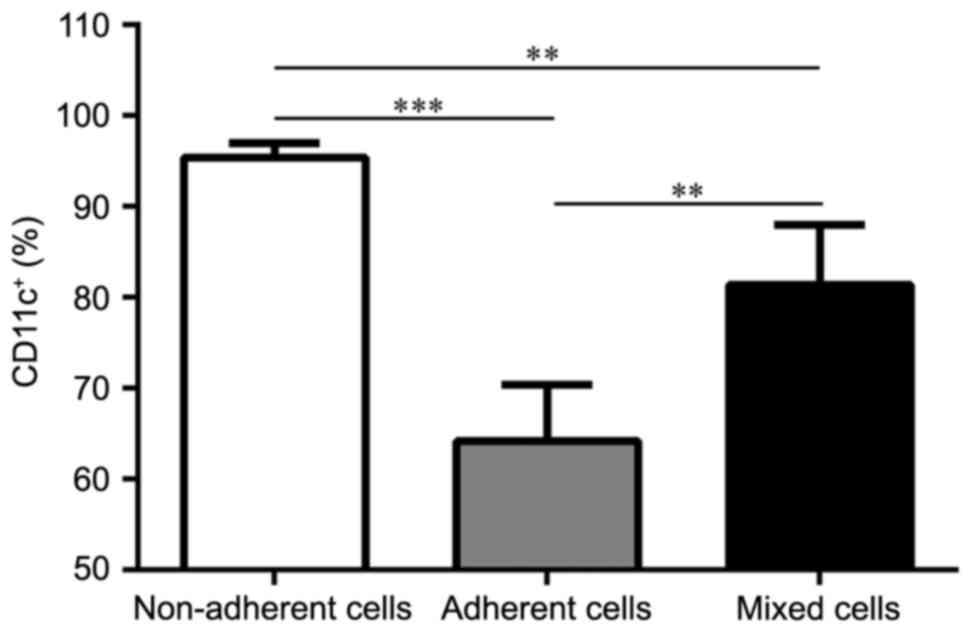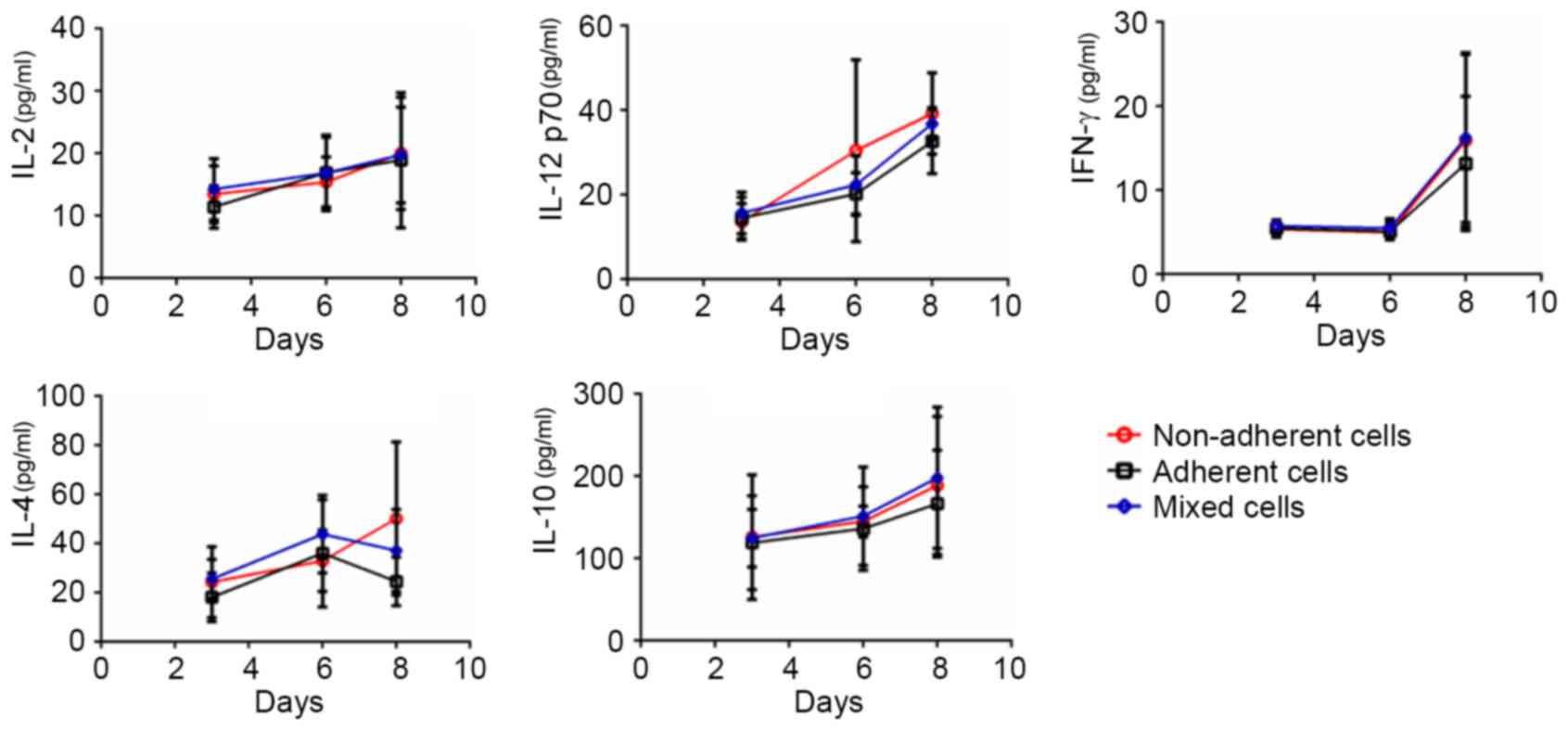|
1
|
Banchereau J and Steinman RM: Dendritic
cells and the control of immunity. Nature. 392:245–252. 1998.
View Article : Google Scholar : PubMed/NCBI
|
|
2
|
Wang J, Zhao LB, Chang S, Ming CS, Yang J
and Gong NQ: Dynamic changes of phenotypes and secretory functions
during the differentiation of pre-DCs to mature DCs. J Huazhong
Univ Sci Technolog Med Sci. 37:191–196. 2017.PubMed/NCBI
|
|
3
|
Satpathy AT, Wu X, Albring JC and Murphy
KM: Re(de)fining the dendritic cell lineage. Nat Immunol.
13:1145–1154. 2012. View
Article : Google Scholar : PubMed/NCBI
|
|
4
|
Cortez-Retamozo V, Etzrodt M and Pittet
MJ: Regulation of macrophage and dendritic cell responses by their
lineage precursors. J Innate Immun. 4:411–423. 2012. View Article : Google Scholar : PubMed/NCBI
|
|
5
|
Merad M, Sathe P, Helft J, Miller J and
Mortha A: The dendritic cell lineage: Ontogeny and function of
dendritic cells and their subsets in the steady state and the
inflamed setting. Annu Rev Immunol. 31:563–604. 2013. View Article : Google Scholar : PubMed/NCBI
|
|
6
|
Shurin MR, Pandharipande PP, Zorina TD,
Haluszczak C, Subbotin VM, Hunter O, Brumfield A, Storkus WJ,
Maraskovsky E and Lotze MT: FLT3 ligand induces the generation of
functionally active dendritic cells in mice. Cell Immunol.
179:174–184. 1997. View Article : Google Scholar : PubMed/NCBI
|
|
7
|
Naik SH, Proietto AI, Wilson NS, Dakic A,
Schnorrer P, Fuchsberger M, Lahoud MH, O'Keeffe M, Shao QX, Chen
WF, et al: Cutting edge: Generation of splenic CD8+ and
CD8+ dendritic cell equivalents in Fms-like tyrosine
kinase 3 ligand bone marrow cultures. J Immunol. 174:6592–6597.
2005. View Article : Google Scholar : PubMed/NCBI
|
|
8
|
Yi HJ and Lu GX: Adherent and non-adherent
dendritic cells are equivalently qualified in GM-CSF, IL-4 and
TNF-α culture system. Cell Immunol. 277:44–48. 2012. View Article : Google Scholar : PubMed/NCBI
|
|
9
|
Kalantari T, Kamali-Sarvestani E, Zhang
GX, Safavi F, Lauretti E, Khedmati ME and Rostami A: Generation of
large numbers of highly purified dendritic cells from bone marrow
progenitor cells after co-culture with syngeneic murine
splenocytes. Exp Mol Pathol. 94:336–342. 2013. View Article : Google Scholar : PubMed/NCBI
|
|
10
|
Delirezh N and Shojaeefar E: Phenotypic
and functional comparison between flask adherent and magnetic
activated cell sorted monocytes derived dendritic cells. Iran J
Immunol. 9:98–108. 2012.PubMed/NCBI
|
|
11
|
Abdi K, Singh NJ and Matzinger P:
Lipopolysaccharide-activated dendritic cells: ‘Exhausted’ or alert
and waiting? J Immunol. 188:5981–5989. 2012. View Article : Google Scholar : PubMed/NCBI
|
|
12
|
Kushwah R, Wu J, Oliver JR, Jiang G, Zhang
J, Siminovitch KA and Hu J: Uptake of apoptotic DC converts
immature DC into tolerogenic DC that induce differentiation of
Foxp3+ Treg. Eur J Immunol. 40:1022–1035. 2010.
View Article : Google Scholar : PubMed/NCBI
|
|
13
|
Pantel A, Teixeira A, Haddad E, Wood EG,
Steinman RM and Longhi MP: Direct type I IFN but not MDA5/TLR3
activation of dendritic cells is required for maturation and
metabolic shift to glycolysis after poly IC stimulation. PLoS Biol.
12:e10017592014. View Article : Google Scholar : PubMed/NCBI
|
|
14
|
Wang Y, Cao Y, Meng Y, You Z, Liu X and
Liu Z: The novel role of thymopentin in induction of maturation of
bone marrow dendritic cells (BMDCs). Int Immunopharmacol.
21:255–260. 2014. View Article : Google Scholar : PubMed/NCBI
|
|
15
|
Li R, Zheng X, Popov I, Zhang X, Wang H,
Suzuki M, Necochea-Campion RD, French PW, Chen D, Siu L, et al:
Gene silencing of IL-12 in dendritic cells inhibits autoimmune
arthritis. J Transl Med. 10:192012. View Article : Google Scholar : PubMed/NCBI
|
|
16
|
Song Q, Meng Y, Wang Y, Li M, Zhang J, Xin
S, Wang L and Shan F: Maturation inside and outside bone marrow
dendritic cells (BMDCs) modulated by interferon-α (IFN-α). Int
Immunopharmacol. 17:843–849. 2013. View Article : Google Scholar : PubMed/NCBI
|
|
17
|
Inaba K, Inaba M, Romani N, Aya H, Deguchi
M, Ikehara S, Muramatsu S and Steinman RM: Generation of large
numbers of dendritic cells from mouse bone marrow cultures
supplemented with granulocyte/macrophage colony-stimulating factor.
J Exp Med. 176:1693–1702. 1992. View Article : Google Scholar : PubMed/NCBI
|
|
18
|
Schmid MA, Kingston D, Boddupalli S and
Manz MG: Instructive cytokine signals in dendritic cell lineage
commitment. Immunol Rev. 234:32–44. 2010. View Article : Google Scholar : PubMed/NCBI
|
|
19
|
Kunieda Y, Tamura Y, Sasaki H, Kurokawa Y,
Miyagishima T, Ohae Y, Hige S, Gotohda Y, Tanaka J, Higuchi A, et
al: Carcinoid of the papilla of Vater-somatostatinoma-a case
report. Gan No Rinsho. 32:831–836. 1986.(In Japanese). PubMed/NCBI
|
|
20
|
Sela U, Olds P, Park A, Schlesinger SJ and
Steinman RM: Dendritic cells induce antigen-specific regulatory T
cells that prevent graft versus host disease and persist in mice. J
Exp Med. 208:2489–2496. 2011. View Article : Google Scholar : PubMed/NCBI
|
|
21
|
Lyons AB and Parish CR: Determination of
lymphocyte division by flow cytometry. J Immunol Methods.
171:131–137. 1994. View Article : Google Scholar : PubMed/NCBI
|
|
22
|
Pinto LA, Galvão Castro B, Soares MB and
Grassi MF: An evaluation of the spontaneous proliferation of
peripheral blood mononuclear cells in HTLV-1-infected individuals
using flow cytometry. ISRN Oncol. 2011:3267192011.PubMed/NCBI
|
|
23
|
Haniffa M, Collin M and Ginhoux F:
Ontogeny and functional specialization of dendritic cells in human
and mouse. Adv Immunol. 120:1–49. 2013. View Article : Google Scholar : PubMed/NCBI
|
|
24
|
Steinman RM and Cohn ZA: Identification of
a novel cell type in peripheral lymphoid organs of mice. I.
Morphology, quantitation, tissue distribution. J Exp Med.
137:1142–1162. 1973. View Article : Google Scholar : PubMed/NCBI
|
|
25
|
Lutz MB, Kukutsch N, Ogilvie AL, Rössner
S, Koch F, Romani N and Schuler G: An advanced culture method for
generating large quantities of highly pure dendritic cells from
mouse bone marrow. J Immunol Methods. 223:77–92. 1999. View Article : Google Scholar : PubMed/NCBI
|
|
26
|
Merad M and Manz MG: Dendritic cell
homeostasis. Blood. 113:3418–3427. 2009. View Article : Google Scholar : PubMed/NCBI
|
|
27
|
Weigel BJ, Nath N, Taylor PA,
Panoskaltsis-Mortari A, Chen W, Krieg AM, Brasel K and Blazar BR:
Comparative analysis of murine marrow-derived dendritic cells
generated by Flt3L or GM-CSF/IL-4 and matured with immune
stimulatory agents on the in vivo induction of antileukemia
responses. Blood. 100:4169–4176. 2002. View Article : Google Scholar : PubMed/NCBI
|
|
28
|
Dudek AM, Martin S, Garg AD and Agostinis
P: Immature, Semi-Mature, and fully mature dendritic cells: Toward
a DC-cancer cells interface that augments anticancer immunity.
Front Immunol. 4:4382013. View Article : Google Scholar : PubMed/NCBI
|
|
29
|
Strome SE, Voss S, Wilcox R, Wakefield TL,
Tamada K, Flies D, Chapoval A, Lu J, Kasperbauer JL, Padley D, et
al: Strategies for antigen loading of dendritic cells to enhance
the antitumor immune response. Cancer Res. 62:1884–1889.
2002.PubMed/NCBI
|
|
30
|
Beriou G, Moreau A and Cuturi MC:
Tolerogenic dendritic cells: Applications for solid organ
transplantation. Curr Opin Organ Transplant. 17:42–47. 2012.
View Article : Google Scholar : PubMed/NCBI
|
|
31
|
Kim SJ and Diamond B: Modulation of
tolerogenic dendritic cells and autoimmunity. Semin Cell Dev Biol.
41:49–58. 2015. View Article : Google Scholar : PubMed/NCBI
|














